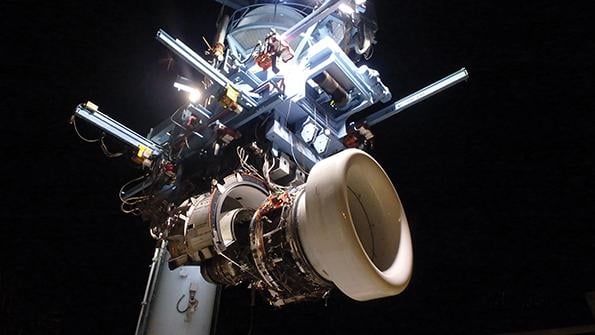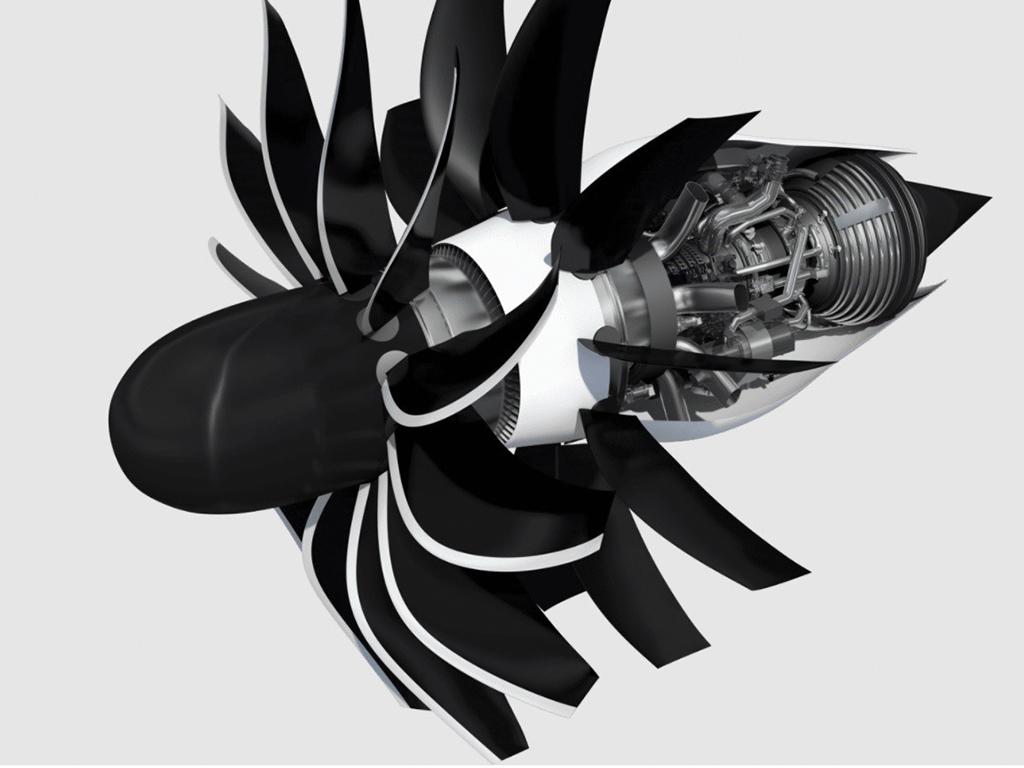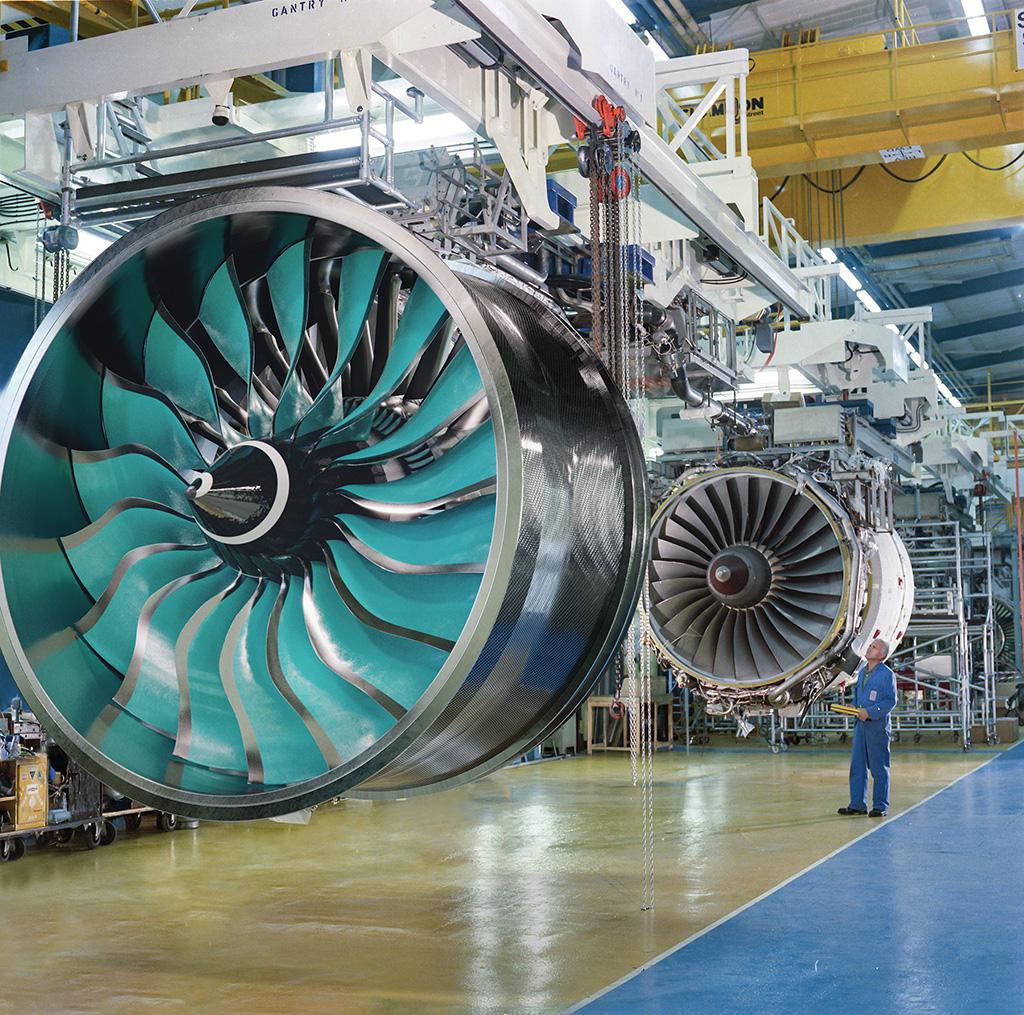
Absent for 20 years, open-rotor engines are back on the power agenda for next-generation single-aisle aircraft. What does that mean for the future of conventional turbofans, geared or otherwise, and how might that technology influence the trajectory of tomorrow’s large-engine designs?

These and other questions follow CFM International’s recent seismic decision to focus on an open-fan demonstrator as the most promising route toward a more sustainable successor to today’s medium-thrust turbofans. Aftershocks from the June announcement are still rumbling through the industry and already appear to have factored into the apparent slowdown of Boeing’s next all-new airliner studies.
- RISE affirms geared engines, CFM competitors say
- Integration, certification and noise challenges face open-fan design
The General Electric and Safran joint venture program, called Revolutionary Innovation for Sustainable Engines (RISE), targets a 20% reduction in fuel consumption and carbon dioxide emissions compared with current engines and is squarely aimed at a successor to the current Leap 1 turbofan in the 20,000-35,000-lb.-thrust class. The demonstrator program is expected to culminate in 2024-25 with flight tests of a single-stage, gear-driven fan paired with active stators in a tractor configuration—a design never previously tested at full scale.
Yet the RISE effort, which incorporates planned tests of a rotor more than 12 ft. in diameter, is about far more than just the propulsor. The demonstrator program will also include a suite of disruptive technologies that support CFM’s long-term sustainability goals. Among these technologies are multiple new combustor designs to ensure future compatibility with both sustainable aviation fuels and liquid hydrogen. The program also embraces the integration of motors and starter-generators for hybrid-electric adaptation.
Beyond these features, RISE will also include the test and development of a compact high-pressure core to boost thermodynamic efficiency as well as a recuperating system to preheat combustion air with waste heat from the exhaust. In addition, the demonstrator will incorporate the use of advanced materials such as ceramic matrix composites in the hot section and resin-transfer-molded composite fan blades.
Other than the overall open-fan concept itself, however, most if not all these technology areas are also being tackled in some form or other by competitors Pratt & Whitney and Rolls-Royce. The big “new” area, as CFM’s challengers see it, is the low-pressure turbine-driven gearbox interposed between the booster (compressor) and the rotating fan stage.
“It’s still a geared turbofan [GTF]—they downplay that aspect of it—but you cannot make that configuration without a gear configuration,” says Michael Winter, senior fellow for advanced technology at Pratt & Whitney. “In essence, this really is a full-on affirmation that geared turbofans are the future—full stop.” If the open fan does not prove feasible for various aeromechanical or certification-related reasons, the baseline development would also clearly support an alternate ducted, geared-fan configuration. CFM declined to be interviewed for this story, but speaking for Pratt, Winters says: “That is consistent with our assessment.”
After more than a decade of research in Europe and the U.S. into optimized blade designs for aeroacoustics, noise is no longer considered a showstopper for open rotors. Although acoustic challenges remain, the focus is shifting to the equally significant hurdles of integration, mechanical complexity and certification.
CFM believes integration with conventional tube-and-wing configurations will be easier because the overall diameter of its open-fan design has shrunk. When open rotors were tested and flown in the 1980s, they required fans up to 16 ft. in diameter to match the power of a midthrust engine, compared with a planned diameter of just more than 12 ft. for RISE. Although this represents a significant improvement, it still presents an installation challenge for wing mounting on aircraft such as the current single-aisle generation. The Leap 1A on the Airbus A320neo, which is enclosed in a 8.3-ft.-deep nacelle, has a ground clearance of just over 1.5 ft.

Even if an open fan is cantilevered up and forward of the wing, Winters says the turbulent wake of the rotor will mitigate against many of the aerodynamic advantages planned for the efficient high-aspect-ratio wing designs under study for next-generation aircraft. “One way Boeing picked up so much efficiency on the 787 wing was by maintaining laminar flow for much of the front section,” he says.
“If you think about where Boeing wants to go with a truss-braced wing in that same time frame—the company’s ongoing transonic truss-braced wing (TTBW) concept study with NASA—it’s a really long, really thin wing,” Winters says. “And for all intents and purposes, I believe it’s assuming laminar flow.” This aerodynamic advantage, he adds, would likely be lost in the wake downstream of an open fan.
Another major integration hurdle will be protecting the structure from blade loss and subsequent imbalance forces, Winter says. Plans to flight-test the Safran-developed counter-rotating open-rotor test engine—the forerunner to RISE—on an Airbus A340 flying testbed were shelved in 2017 after concerns arose about airframe strengthening and weight gain around the tail to counter potential blade separation events.
Winter says open rotors might represent a more significant installation challenge for advanced configurations such as the TTBW. “That truss is a safety-critical structure, and you’ve got this big whirling mass right next to it with the possibility of losing a blade. So you have to worry about the imbalance loads and the structural mass associated with coping with those,” he adds.
CFM notes, however, that the demonstrator will also pave the way for development of a certified product, various issues for which were considered as early as 2015 in a European Union Aviation Safety Agency (EASA) notice of proposed amendment. “The open-rotor concept is not intended to be certified as a propeller-engine installation,” EASA says. “Due to the complex integration, it is instead intended to be certified as an integrated engine concept.”
Based on current airframe and engine certification requirements, the open-fan propulsion system is likely to meet existing turboprop rules, under which the propeller manufacturer has to demonstrate, by design and tests, that a fan blade will not detach. In addition, the system will also have to meet current requirements on blade pitch control and avoiding overspeed conditions. Blade-off requirements similar to current turbofan regulations will also be a factor.
Rolls-Royce, which has bet its future on the geared, ducted UltraFan family, is also skeptical about the prospects for the broader applicability of the open-fan concept. “The ducted fan is far and away the most versatile, and an entirely necessary, solution,” says Andy Geer, chief engineer of UltraFan product development and technology. “You can come up with open-rotor and maybe open-fan configurations for bespoke short-range small airplane applications, perhaps, but only if those applications can tolerate the installation challenges and the sort of cruise-speed limitations that are likely to go with that kind of architecture.”
The issue becomes even more critical with the increasing scale necessary for higher-power needs. Geer says the flow physics for such a requirement demands that for the same overall thrust, the open-fan engine will have roughly twice the diameter of a ducted fan. “Our view is neither of those compromises would work in a widebody, long-range application. Realistically, they’re completely outclassed by an UltraFan ducted turbofan on [such an] application,” he adds.
“There seems to be a fundamental divide from our perspective,” Geer continues. “From a cruise-speed limitation perspective, unless you’re prepared to push an open-rotor system to very high tip speeds to try to overcome some of the shortfalls of not being ducted, you will gain speed. But as soon as you do that, you’ve got a noise problem.”
As Rolls-Royce prepares to begin ground tests of the first UltraFan demonstrator in early 2022 and Pratt works on a road map of upgrades to the GTF, it appears that neither company plans to change course or alter its development strategy as a result of CFM’s RISE initiative. Yet the two manufacturers are in very different positions: Rolls is years away from debuting the new engine and has yet to secure an application for its UltraFan, while Pratt is building on a bridgehead established with an engine family that first ran in ground tests as far back as 2007.

In the near term, Pratt is preparing to launch an upgrade package for the PW1100G version that will provide the option of additional thrust for heavier weight applications, such as the Airbus A321XLR, while maintaining time on wing. The focus is on delivering additional power and reliability rather than lower fuel burn, Winter says.
“The beauty is that we do have that technology and we could take advantage of it, but we don’t have to,” he adds. “We could change the gear ratio and get a lot more performance, but we chose to optimize on what the customer values. That’s not only efficiency—it’s also time on wing and thrust.”
Down the line, Pratt is evaluating further improvements, including short duct inlets and adapting the PW1000G family for a more electric future. The short duct work, which would help reduce the weight and drag of the nacelle, would build on earlier tests of advanced inlets conducted as part of the FAA’s CLEEN environmental program. Plans to develop the engine into a parallel turboelectric hybrid include adding a motor-starter generator mounted on the engine’s high-pressure spool and a motor generator on the low-pressure spool.
These plans will leverage NASA’s Electrified Powertrain Flight Demonstration project, under which Pratt hopes to play a key role in flight testing a megawatt-class electric-aircraft-propulsion system on its Boeing 747SP flying testbed. The program forms part of NASA’s broader aviation sustainability strategy and aims to mature propulsion systems for thin-haul, regional and single-aisle aircraft that could enter service by 2035.
To accelerate the process and mature powertrain technology to a level ready to enter product development and certification in the late 2020s, NASA intends to use existing or planned industry flying testbeds and is expected to issue contracts later this year.


Comments